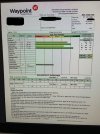Hey all, just wondering what you recommend for fertilzer on brassicas? My local coop recommended 150# of AMS, 100# of MESZ, and 200# of potash per acre which amounts to about 43.5# of nitrogen per acre if I did the math right. That sounds a bit low doesn't it? I thought it was recommended to use like 50 to 100# of nitrogen per acre is that correct?
thanks!
I use none. Since I've stopped tillage and gone to non-till/min-till methods, I've stopped using all fertilizer. I never plant brassica as a standalone crop. I always plant it as part of a mix that includes legumes. I also plant it as part of a rotation that includes legumes. The improved nutrient cycling I'm seeing from improved soil health along with a complementary selection of crops both mixing and rotating, I have used no fertilizer for over 4 years.
In a mix, I try not to exceed 2 or 3 lbs/ac of most brassica. I use turnips and radish a lot as my choice for the brassica component. My choice of deer food consists mostly of low fertility requirement crops, so have a small amount of higher fertility requiring crops like some brassica in the mix does not require commercial fertilizer.
Here is the formula I've been using lately. Keep in mind that I'm far enough south that summer is a slightly greater stress period than winter. In the fields where I rotate annuals, I start by planting a mix of sunn hemp and buckwheat in the late spring. Sunn hemp is a legume that fixes a lot of N into the soil. Buckwheat scavenges nutrients from the soil and decays quickly releasing them for the next crop when terminated. In late summer/early fall, I rotate into my fall mix. I like Winter Rye, Purple Top Turnips, and Crimson Clover as my primary fall mix. The winter rye is my early season attractant. The crimson clover comes on in mid season. After we get some good frosts, the turnip tops sweeten and become attractive. Late season and post season, the turnip bulbs become good deer food into late winter.
In early spring, the WR is still attractive but it becomes old and less attractive as spring continues, but in my area, Crimson clover acts as a reseeding annual and comes on strong. The turnips flower and need to be terminated before they bolt, so i bushhog the field. This sets back the WR and releases the crimson clover even more. The set back WR helps when it comes planting the next sunn hemp buckwheat crop in the late spring using no-till/min-till methods. It keeps the amount of vegetation manageable compared to letting the WR grow unmowed until planting time.
Using this selection of crops and rotation has been working well for me with zero fertilizer added. Fertilizer is a high cost input and planting without it allows me to plant more acreage. Both my crops and my deer usage of them have not suffered since I've stopped using fertilizer. While this specific rotation of crops works for me, in other areas different rotations may work better. The key is planting mostly low fertility requirement crops with complementary characteristics in mix and rotation.
One point to think about when considering fertilizer. Most soil tests don't measure N. The N component of most fertilizer recommendations come from a crops needs without respect to the amount of N in your soil and are intended for farmers growing monocultures. In most cases, they are much higher than are needed for smart food plots.
Thanks,
Jack


